Report on Contemporary Accounting Theory - ACCT20074
VerifiedAdded on 2023/04/04
|19
|3748
|429
Report
AI Summary
This report provides a comprehensive analysis of contemporary accounting theory, examining the conceptual framework for financial reporting in the USA, UK, Australia, and globally, as per IASB. It discusses the concerns of the Australian accounting profession regarding the application of the IASB/IFRS Conceptual Framework. The report also explores academic concerns about the quality of the conceptual framework, outlining its potential benefits and limitations. The report then delves into integrated and sustainability reporting, comparing and contrasting guidelines from GRI and IIRF, and analyzing the strengths and limitations of conventional accounting. It applies relevant theories to explain the content of integrated reports, using the integrated reports of Stockland Units and Vukile Property as case studies. The report concludes with a summary of findings and recommendations.
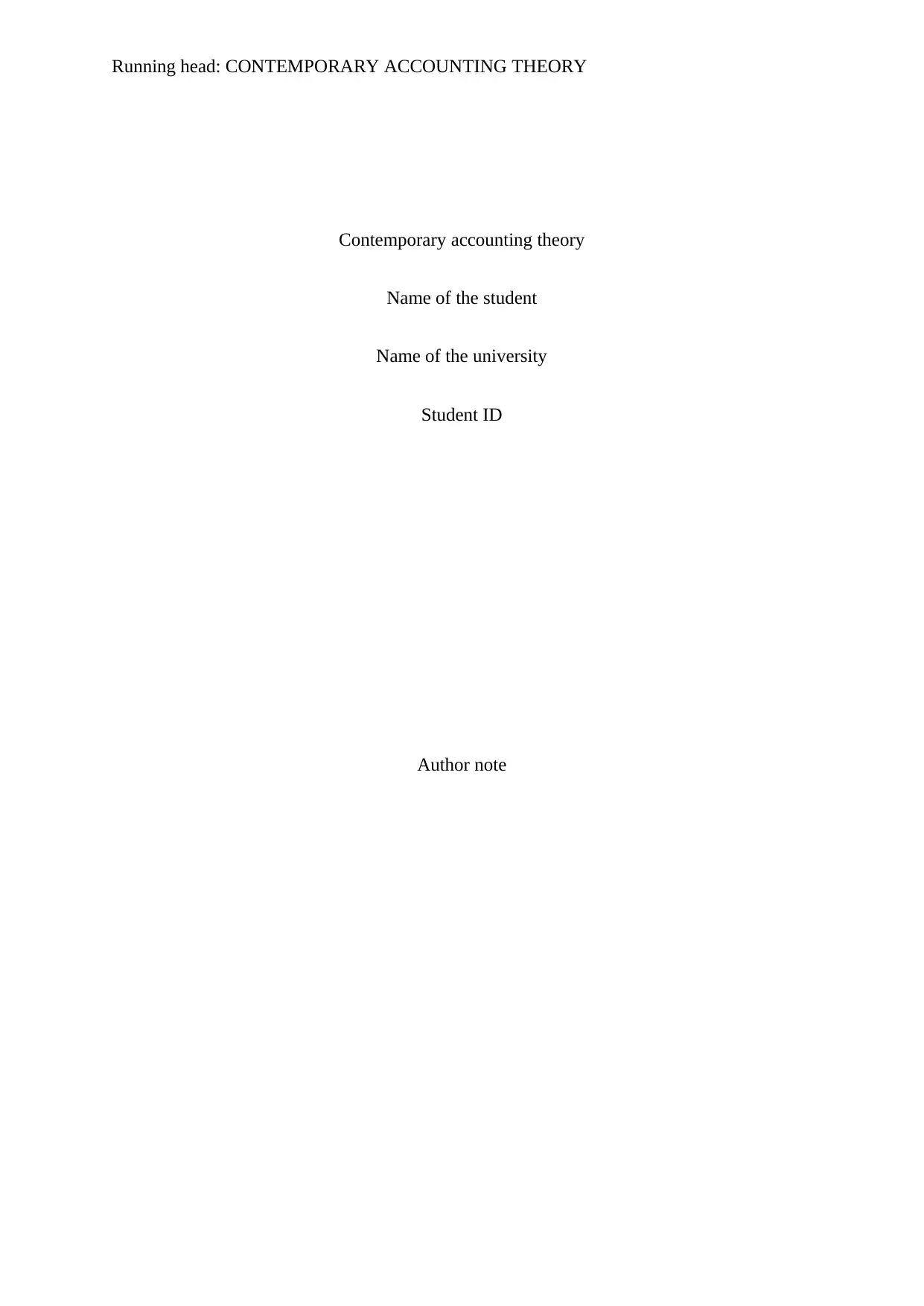
Running head: CONTEMPORARY ACCOUNTING THEORY
Contemporary accounting theory
Name of the student
Name of the university
Student ID
Author note
Contemporary accounting theory
Name of the student
Name of the university
Student ID
Author note
Paraphrase This Document
Need a fresh take? Get an instant paraphrase of this document with our AI Paraphraser
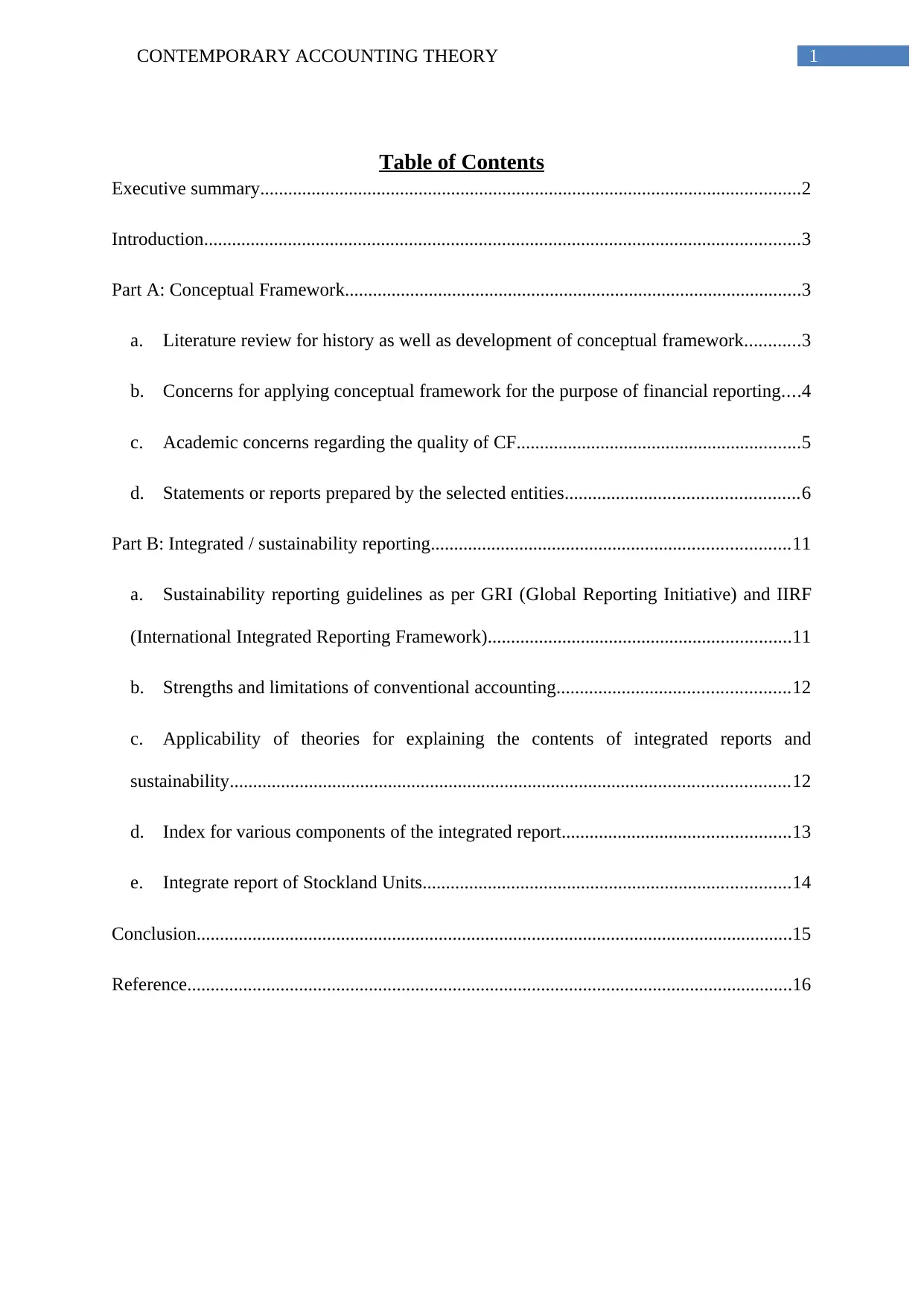
1CONTEMPORARY ACCOUNTING THEORY
Table of Contents
Executive summary....................................................................................................................2
Introduction................................................................................................................................3
Part A: Conceptual Framework..................................................................................................3
a. Literature review for history as well as development of conceptual framework............3
b. Concerns for applying conceptual framework for the purpose of financial reporting....4
c. Academic concerns regarding the quality of CF.............................................................5
d. Statements or reports prepared by the selected entities..................................................6
Part B: Integrated / sustainability reporting.............................................................................11
a. Sustainability reporting guidelines as per GRI (Global Reporting Initiative) and IIRF
(International Integrated Reporting Framework).................................................................11
b. Strengths and limitations of conventional accounting..................................................12
c. Applicability of theories for explaining the contents of integrated reports and
sustainability........................................................................................................................12
d. Index for various components of the integrated report.................................................13
e. Integrate report of Stockland Units...............................................................................14
Conclusion................................................................................................................................15
Reference..................................................................................................................................16
Table of Contents
Executive summary....................................................................................................................2
Introduction................................................................................................................................3
Part A: Conceptual Framework..................................................................................................3
a. Literature review for history as well as development of conceptual framework............3
b. Concerns for applying conceptual framework for the purpose of financial reporting....4
c. Academic concerns regarding the quality of CF.............................................................5
d. Statements or reports prepared by the selected entities..................................................6
Part B: Integrated / sustainability reporting.............................................................................11
a. Sustainability reporting guidelines as per GRI (Global Reporting Initiative) and IIRF
(International Integrated Reporting Framework).................................................................11
b. Strengths and limitations of conventional accounting..................................................12
c. Applicability of theories for explaining the contents of integrated reports and
sustainability........................................................................................................................12
d. Index for various components of the integrated report.................................................13
e. Integrate report of Stockland Units...............................................................................14
Conclusion................................................................................................................................15
Reference..................................................................................................................................16
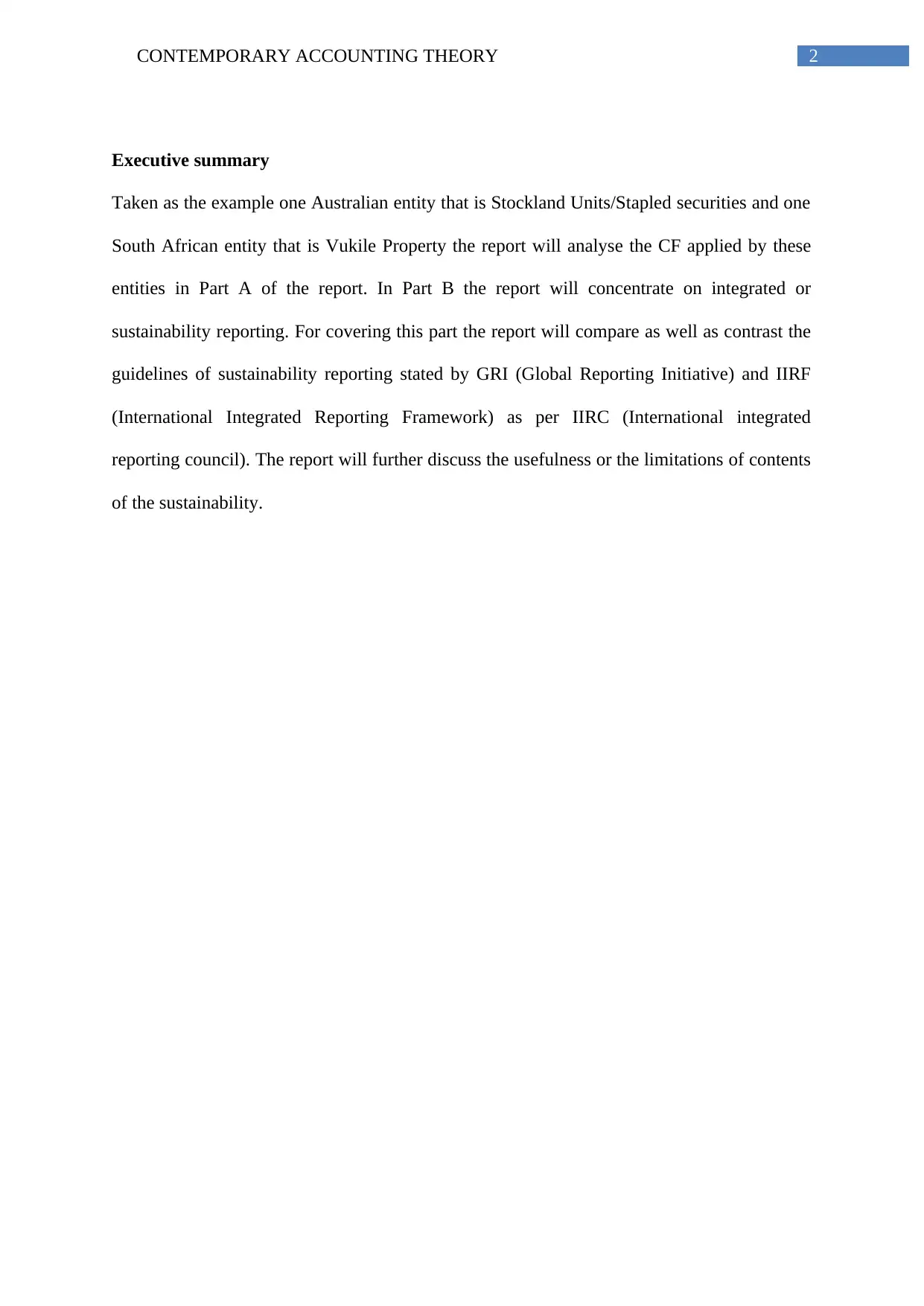
2CONTEMPORARY ACCOUNTING THEORY
Executive summary
Taken as the example one Australian entity that is Stockland Units/Stapled securities and one
South African entity that is Vukile Property the report will analyse the CF applied by these
entities in Part A of the report. In Part B the report will concentrate on integrated or
sustainability reporting. For covering this part the report will compare as well as contrast the
guidelines of sustainability reporting stated by GRI (Global Reporting Initiative) and IIRF
(International Integrated Reporting Framework) as per IIRC (International integrated
reporting council). The report will further discuss the usefulness or the limitations of contents
of the sustainability.
Executive summary
Taken as the example one Australian entity that is Stockland Units/Stapled securities and one
South African entity that is Vukile Property the report will analyse the CF applied by these
entities in Part A of the report. In Part B the report will concentrate on integrated or
sustainability reporting. For covering this part the report will compare as well as contrast the
guidelines of sustainability reporting stated by GRI (Global Reporting Initiative) and IIRF
(International Integrated Reporting Framework) as per IIRC (International integrated
reporting council). The report will further discuss the usefulness or the limitations of contents
of the sustainability.
⊘ This is a preview!⊘
Do you want full access?
Subscribe today to unlock all pages.

Trusted by 1+ million students worldwide
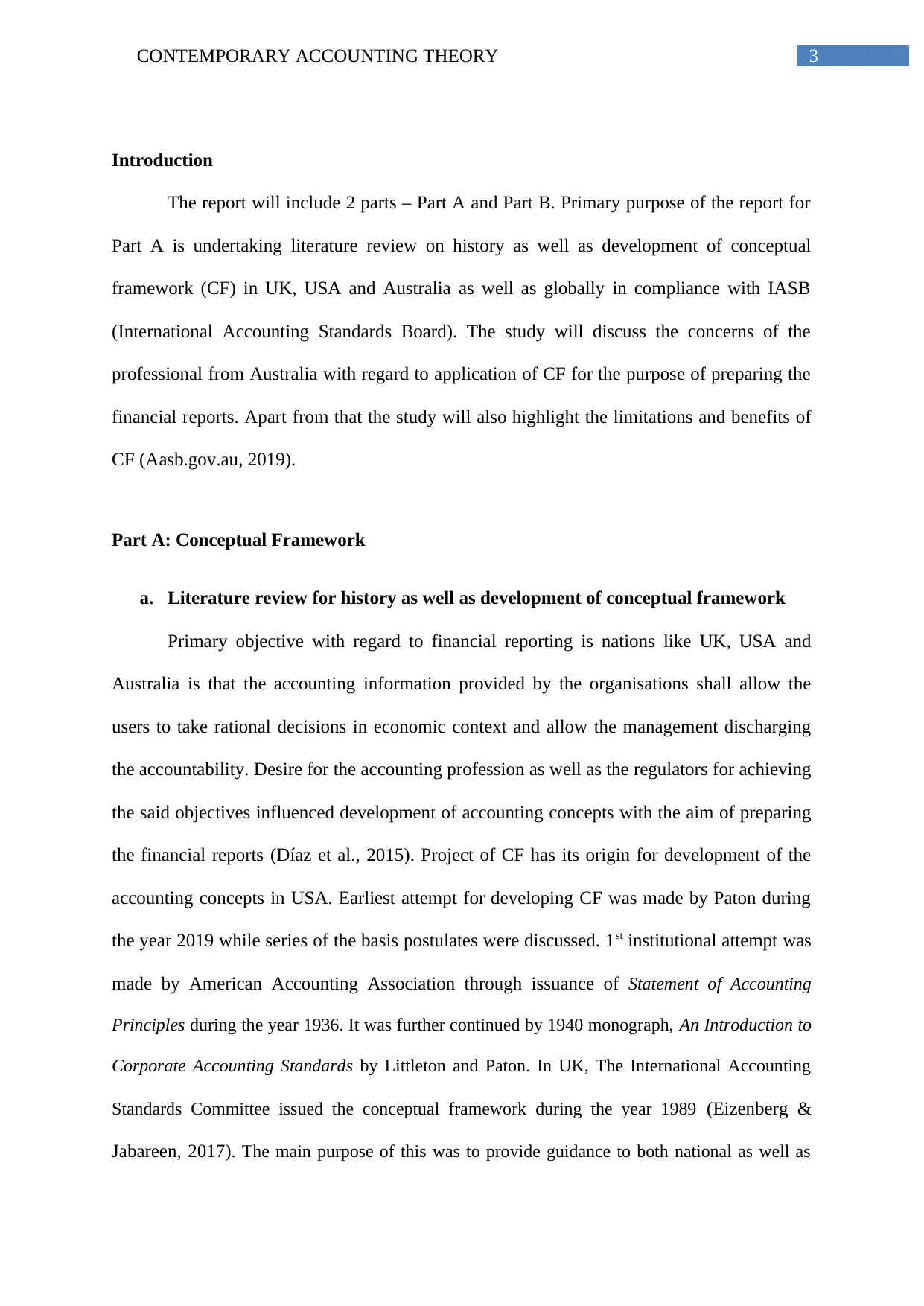
3CONTEMPORARY ACCOUNTING THEORY
Introduction
The report will include 2 parts – Part A and Part B. Primary purpose of the report for
Part A is undertaking literature review on history as well as development of conceptual
framework (CF) in UK, USA and Australia as well as globally in compliance with IASB
(International Accounting Standards Board). The study will discuss the concerns of the
professional from Australia with regard to application of CF for the purpose of preparing the
financial reports. Apart from that the study will also highlight the limitations and benefits of
CF (Aasb.gov.au, 2019).
Part A: Conceptual Framework
a. Literature review for history as well as development of conceptual framework
Primary objective with regard to financial reporting is nations like UK, USA and
Australia is that the accounting information provided by the organisations shall allow the
users to take rational decisions in economic context and allow the management discharging
the accountability. Desire for the accounting profession as well as the regulators for achieving
the said objectives influenced development of accounting concepts with the aim of preparing
the financial reports (Díaz et al., 2015). Project of CF has its origin for development of the
accounting concepts in USA. Earliest attempt for developing CF was made by Paton during
the year 2019 while series of the basis postulates were discussed. 1st institutional attempt was
made by American Accounting Association through issuance of Statement of Accounting
Principles during the year 1936. It was further continued by 1940 monograph, An Introduction to
Corporate Accounting Standards by Littleton and Paton. In UK, The International Accounting
Standards Committee issued the conceptual framework during the year 1989 (Eizenberg &
Jabareen, 2017). The main purpose of this was to provide guidance to both national as well as
Introduction
The report will include 2 parts – Part A and Part B. Primary purpose of the report for
Part A is undertaking literature review on history as well as development of conceptual
framework (CF) in UK, USA and Australia as well as globally in compliance with IASB
(International Accounting Standards Board). The study will discuss the concerns of the
professional from Australia with regard to application of CF for the purpose of preparing the
financial reports. Apart from that the study will also highlight the limitations and benefits of
CF (Aasb.gov.au, 2019).
Part A: Conceptual Framework
a. Literature review for history as well as development of conceptual framework
Primary objective with regard to financial reporting is nations like UK, USA and
Australia is that the accounting information provided by the organisations shall allow the
users to take rational decisions in economic context and allow the management discharging
the accountability. Desire for the accounting profession as well as the regulators for achieving
the said objectives influenced development of accounting concepts with the aim of preparing
the financial reports (Díaz et al., 2015). Project of CF has its origin for development of the
accounting concepts in USA. Earliest attempt for developing CF was made by Paton during
the year 2019 while series of the basis postulates were discussed. 1st institutional attempt was
made by American Accounting Association through issuance of Statement of Accounting
Principles during the year 1936. It was further continued by 1940 monograph, An Introduction to
Corporate Accounting Standards by Littleton and Paton. In UK, The International Accounting
Standards Committee issued the conceptual framework during the year 1989 (Eizenberg &
Jabareen, 2017). The main purpose of this was to provide guidance to both national as well as
Paraphrase This Document
Need a fresh take? Get an instant paraphrase of this document with our AI Paraphraser
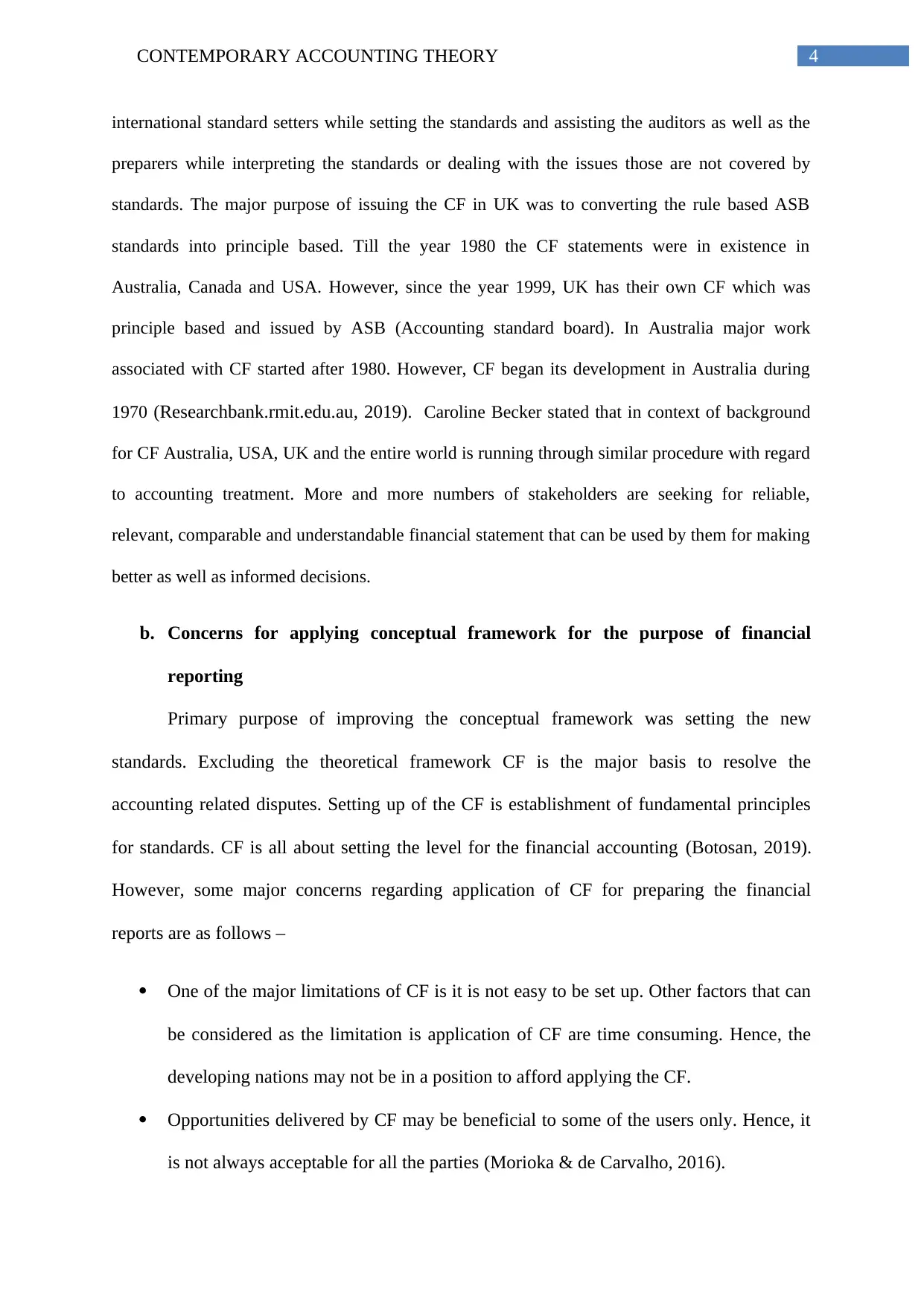
4CONTEMPORARY ACCOUNTING THEORY
international standard setters while setting the standards and assisting the auditors as well as the
preparers while interpreting the standards or dealing with the issues those are not covered by
standards. The major purpose of issuing the CF in UK was to converting the rule based ASB
standards into principle based. Till the year 1980 the CF statements were in existence in
Australia, Canada and USA. However, since the year 1999, UK has their own CF which was
principle based and issued by ASB (Accounting standard board). In Australia major work
associated with CF started after 1980. However, CF began its development in Australia during
1970 (Researchbank.rmit.edu.au, 2019). Caroline Becker stated that in context of background
for CF Australia, USA, UK and the entire world is running through similar procedure with regard
to accounting treatment. More and more numbers of stakeholders are seeking for reliable,
relevant, comparable and understandable financial statement that can be used by them for making
better as well as informed decisions.
b. Concerns for applying conceptual framework for the purpose of financial
reporting
Primary purpose of improving the conceptual framework was setting the new
standards. Excluding the theoretical framework CF is the major basis to resolve the
accounting related disputes. Setting up of the CF is establishment of fundamental principles
for standards. CF is all about setting the level for the financial accounting (Botosan, 2019).
However, some major concerns regarding application of CF for preparing the financial
reports are as follows –
One of the major limitations of CF is it is not easy to be set up. Other factors that can
be considered as the limitation is application of CF are time consuming. Hence, the
developing nations may not be in a position to afford applying the CF.
Opportunities delivered by CF may be beneficial to some of the users only. Hence, it
is not always acceptable for all the parties (Morioka & de Carvalho, 2016).
international standard setters while setting the standards and assisting the auditors as well as the
preparers while interpreting the standards or dealing with the issues those are not covered by
standards. The major purpose of issuing the CF in UK was to converting the rule based ASB
standards into principle based. Till the year 1980 the CF statements were in existence in
Australia, Canada and USA. However, since the year 1999, UK has their own CF which was
principle based and issued by ASB (Accounting standard board). In Australia major work
associated with CF started after 1980. However, CF began its development in Australia during
1970 (Researchbank.rmit.edu.au, 2019). Caroline Becker stated that in context of background
for CF Australia, USA, UK and the entire world is running through similar procedure with regard
to accounting treatment. More and more numbers of stakeholders are seeking for reliable,
relevant, comparable and understandable financial statement that can be used by them for making
better as well as informed decisions.
b. Concerns for applying conceptual framework for the purpose of financial
reporting
Primary purpose of improving the conceptual framework was setting the new
standards. Excluding the theoretical framework CF is the major basis to resolve the
accounting related disputes. Setting up of the CF is establishment of fundamental principles
for standards. CF is all about setting the level for the financial accounting (Botosan, 2019).
However, some major concerns regarding application of CF for preparing the financial
reports are as follows –
One of the major limitations of CF is it is not easy to be set up. Other factors that can
be considered as the limitation is application of CF are time consuming. Hence, the
developing nations may not be in a position to afford applying the CF.
Opportunities delivered by CF may be beneficial to some of the users only. Hence, it
is not always acceptable for all the parties (Morioka & de Carvalho, 2016).
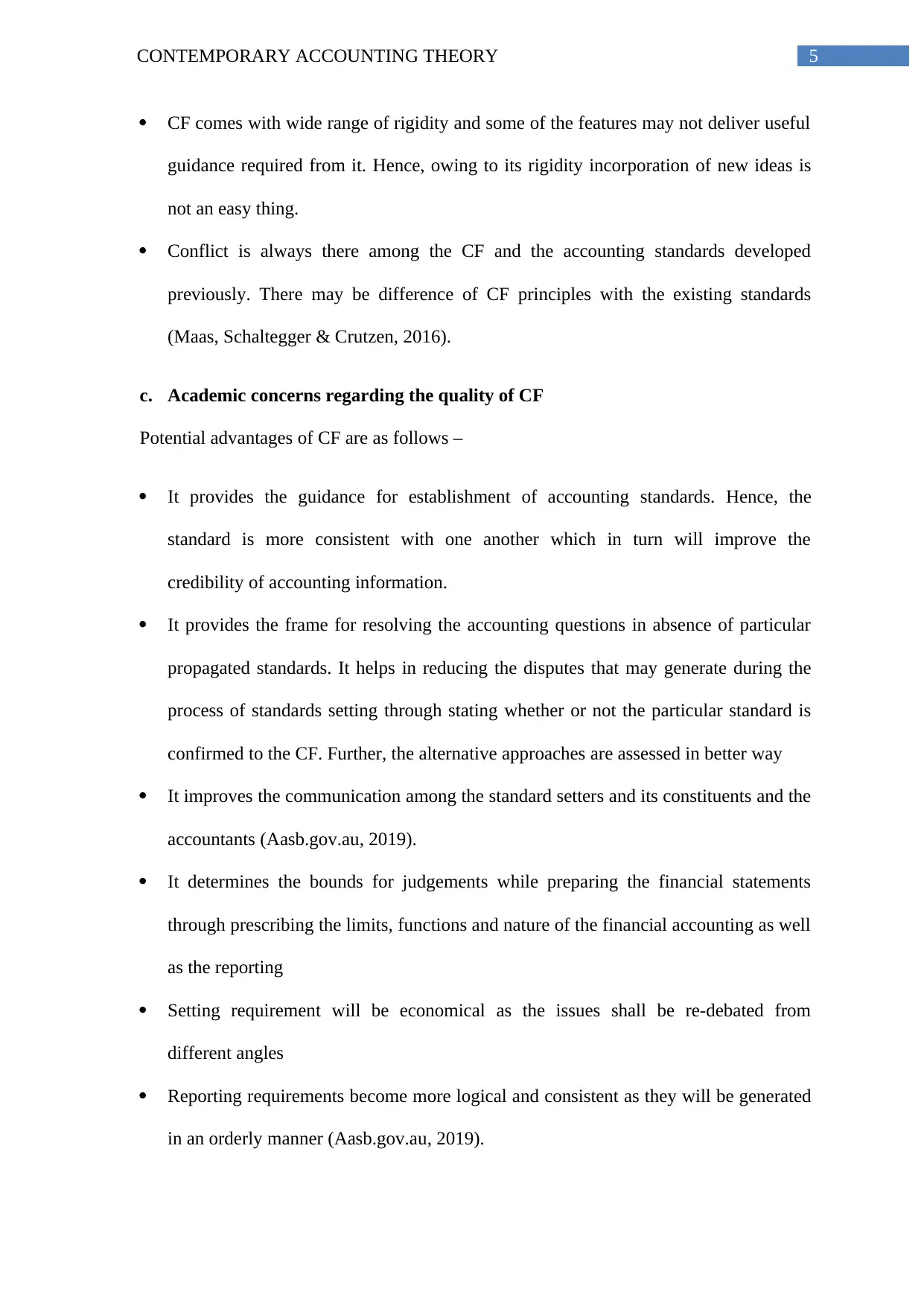
5CONTEMPORARY ACCOUNTING THEORY
CF comes with wide range of rigidity and some of the features may not deliver useful
guidance required from it. Hence, owing to its rigidity incorporation of new ideas is
not an easy thing.
Conflict is always there among the CF and the accounting standards developed
previously. There may be difference of CF principles with the existing standards
(Maas, Schaltegger & Crutzen, 2016).
c. Academic concerns regarding the quality of CF
Potential advantages of CF are as follows –
It provides the guidance for establishment of accounting standards. Hence, the
standard is more consistent with one another which in turn will improve the
credibility of accounting information.
It provides the frame for resolving the accounting questions in absence of particular
propagated standards. It helps in reducing the disputes that may generate during the
process of standards setting through stating whether or not the particular standard is
confirmed to the CF. Further, the alternative approaches are assessed in better way
It improves the communication among the standard setters and its constituents and the
accountants (Aasb.gov.au, 2019).
It determines the bounds for judgements while preparing the financial statements
through prescribing the limits, functions and nature of the financial accounting as well
as the reporting
Setting requirement will be economical as the issues shall be re-debated from
different angles
Reporting requirements become more logical and consistent as they will be generated
in an orderly manner (Aasb.gov.au, 2019).
CF comes with wide range of rigidity and some of the features may not deliver useful
guidance required from it. Hence, owing to its rigidity incorporation of new ideas is
not an easy thing.
Conflict is always there among the CF and the accounting standards developed
previously. There may be difference of CF principles with the existing standards
(Maas, Schaltegger & Crutzen, 2016).
c. Academic concerns regarding the quality of CF
Potential advantages of CF are as follows –
It provides the guidance for establishment of accounting standards. Hence, the
standard is more consistent with one another which in turn will improve the
credibility of accounting information.
It provides the frame for resolving the accounting questions in absence of particular
propagated standards. It helps in reducing the disputes that may generate during the
process of standards setting through stating whether or not the particular standard is
confirmed to the CF. Further, the alternative approaches are assessed in better way
It improves the communication among the standard setters and its constituents and the
accountants (Aasb.gov.au, 2019).
It determines the bounds for judgements while preparing the financial statements
through prescribing the limits, functions and nature of the financial accounting as well
as the reporting
Setting requirement will be economical as the issues shall be re-debated from
different angles
Reporting requirements become more logical and consistent as they will be generated
in an orderly manner (Aasb.gov.au, 2019).
⊘ This is a preview!⊘
Do you want full access?
Subscribe today to unlock all pages.

Trusted by 1+ million students worldwide
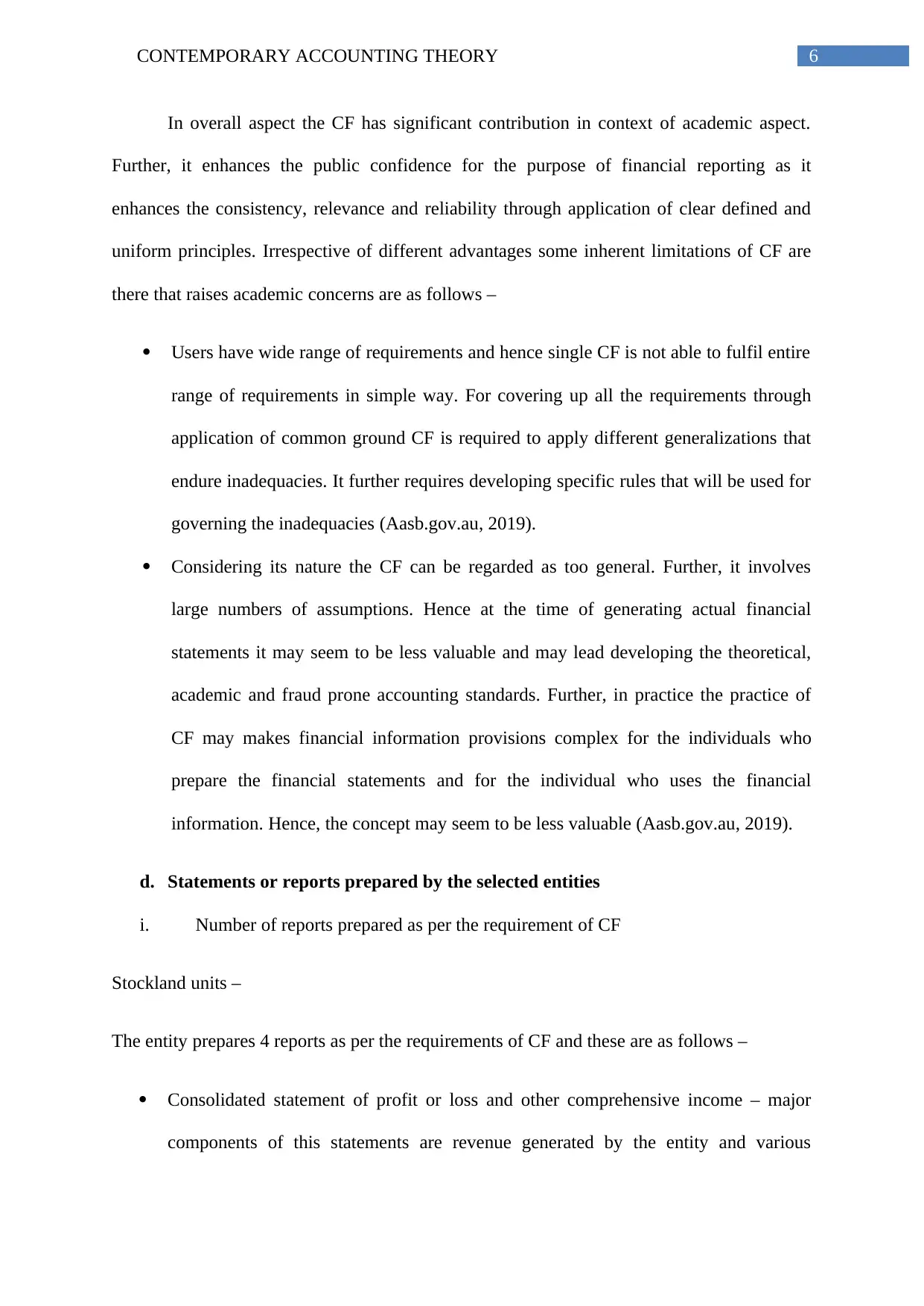
6CONTEMPORARY ACCOUNTING THEORY
In overall aspect the CF has significant contribution in context of academic aspect.
Further, it enhances the public confidence for the purpose of financial reporting as it
enhances the consistency, relevance and reliability through application of clear defined and
uniform principles. Irrespective of different advantages some inherent limitations of CF are
there that raises academic concerns are as follows –
Users have wide range of requirements and hence single CF is not able to fulfil entire
range of requirements in simple way. For covering up all the requirements through
application of common ground CF is required to apply different generalizations that
endure inadequacies. It further requires developing specific rules that will be used for
governing the inadequacies (Aasb.gov.au, 2019).
Considering its nature the CF can be regarded as too general. Further, it involves
large numbers of assumptions. Hence at the time of generating actual financial
statements it may seem to be less valuable and may lead developing the theoretical,
academic and fraud prone accounting standards. Further, in practice the practice of
CF may makes financial information provisions complex for the individuals who
prepare the financial statements and for the individual who uses the financial
information. Hence, the concept may seem to be less valuable (Aasb.gov.au, 2019).
d. Statements or reports prepared by the selected entities
i. Number of reports prepared as per the requirement of CF
Stockland units –
The entity prepares 4 reports as per the requirements of CF and these are as follows –
Consolidated statement of profit or loss and other comprehensive income – major
components of this statements are revenue generated by the entity and various
In overall aspect the CF has significant contribution in context of academic aspect.
Further, it enhances the public confidence for the purpose of financial reporting as it
enhances the consistency, relevance and reliability through application of clear defined and
uniform principles. Irrespective of different advantages some inherent limitations of CF are
there that raises academic concerns are as follows –
Users have wide range of requirements and hence single CF is not able to fulfil entire
range of requirements in simple way. For covering up all the requirements through
application of common ground CF is required to apply different generalizations that
endure inadequacies. It further requires developing specific rules that will be used for
governing the inadequacies (Aasb.gov.au, 2019).
Considering its nature the CF can be regarded as too general. Further, it involves
large numbers of assumptions. Hence at the time of generating actual financial
statements it may seem to be less valuable and may lead developing the theoretical,
academic and fraud prone accounting standards. Further, in practice the practice of
CF may makes financial information provisions complex for the individuals who
prepare the financial statements and for the individual who uses the financial
information. Hence, the concept may seem to be less valuable (Aasb.gov.au, 2019).
d. Statements or reports prepared by the selected entities
i. Number of reports prepared as per the requirement of CF
Stockland units –
The entity prepares 4 reports as per the requirements of CF and these are as follows –
Consolidated statement of profit or loss and other comprehensive income – major
components of this statements are revenue generated by the entity and various
Paraphrase This Document
Need a fresh take? Get an instant paraphrase of this document with our AI Paraphraser
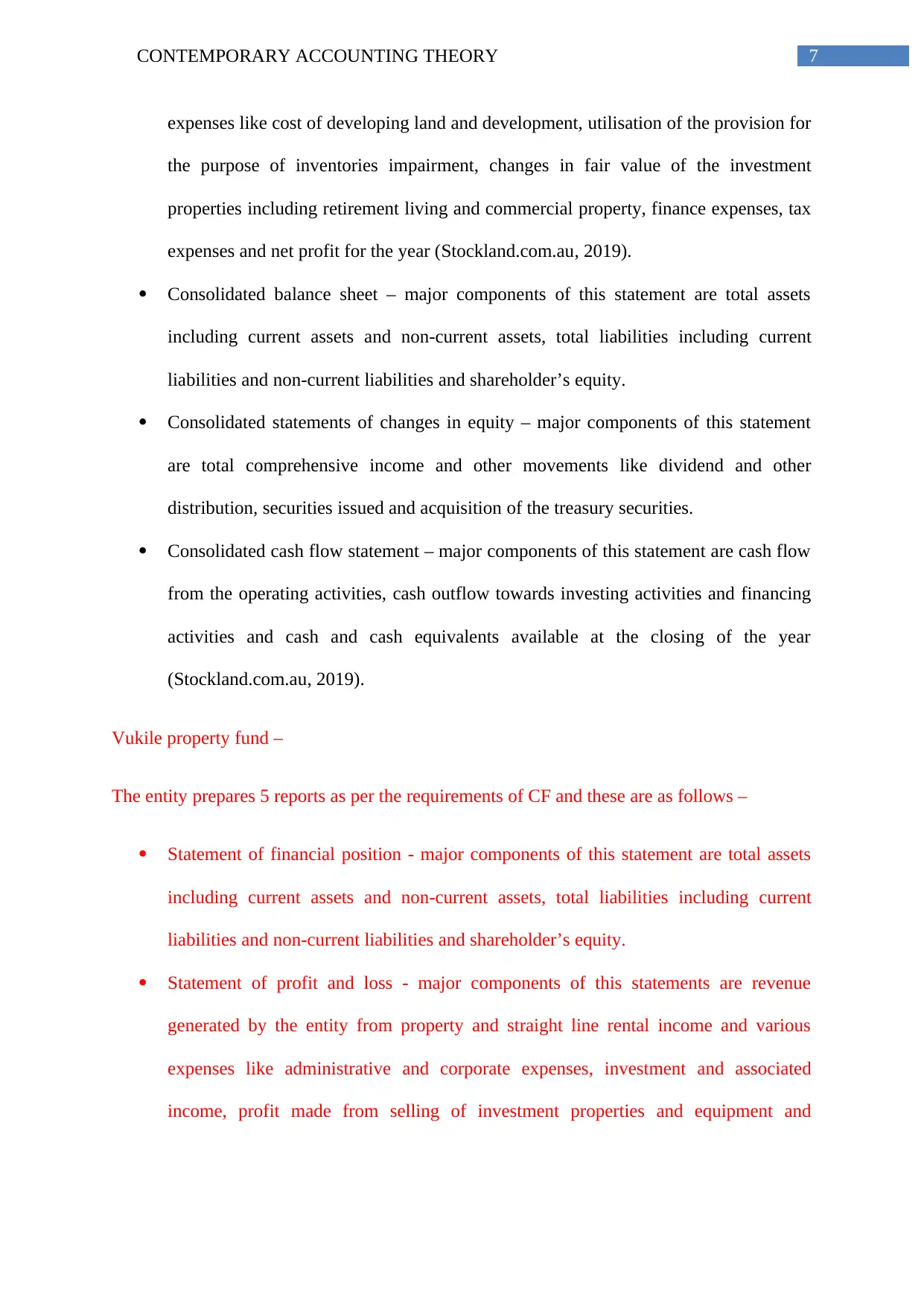
7CONTEMPORARY ACCOUNTING THEORY
expenses like cost of developing land and development, utilisation of the provision for
the purpose of inventories impairment, changes in fair value of the investment
properties including retirement living and commercial property, finance expenses, tax
expenses and net profit for the year (Stockland.com.au, 2019).
Consolidated balance sheet – major components of this statement are total assets
including current assets and non-current assets, total liabilities including current
liabilities and non-current liabilities and shareholder’s equity.
Consolidated statements of changes in equity – major components of this statement
are total comprehensive income and other movements like dividend and other
distribution, securities issued and acquisition of the treasury securities.
Consolidated cash flow statement – major components of this statement are cash flow
from the operating activities, cash outflow towards investing activities and financing
activities and cash and cash equivalents available at the closing of the year
(Stockland.com.au, 2019).
Vukile property fund –
The entity prepares 5 reports as per the requirements of CF and these are as follows –
Statement of financial position - major components of this statement are total assets
including current assets and non-current assets, total liabilities including current
liabilities and non-current liabilities and shareholder’s equity.
Statement of profit and loss - major components of this statements are revenue
generated by the entity from property and straight line rental income and various
expenses like administrative and corporate expenses, investment and associated
income, profit made from selling of investment properties and equipment and
expenses like cost of developing land and development, utilisation of the provision for
the purpose of inventories impairment, changes in fair value of the investment
properties including retirement living and commercial property, finance expenses, tax
expenses and net profit for the year (Stockland.com.au, 2019).
Consolidated balance sheet – major components of this statement are total assets
including current assets and non-current assets, total liabilities including current
liabilities and non-current liabilities and shareholder’s equity.
Consolidated statements of changes in equity – major components of this statement
are total comprehensive income and other movements like dividend and other
distribution, securities issued and acquisition of the treasury securities.
Consolidated cash flow statement – major components of this statement are cash flow
from the operating activities, cash outflow towards investing activities and financing
activities and cash and cash equivalents available at the closing of the year
(Stockland.com.au, 2019).
Vukile property fund –
The entity prepares 5 reports as per the requirements of CF and these are as follows –
Statement of financial position - major components of this statement are total assets
including current assets and non-current assets, total liabilities including current
liabilities and non-current liabilities and shareholder’s equity.
Statement of profit and loss - major components of this statements are revenue
generated by the entity from property and straight line rental income and various
expenses like administrative and corporate expenses, investment and associated
income, profit made from selling of investment properties and equipment and
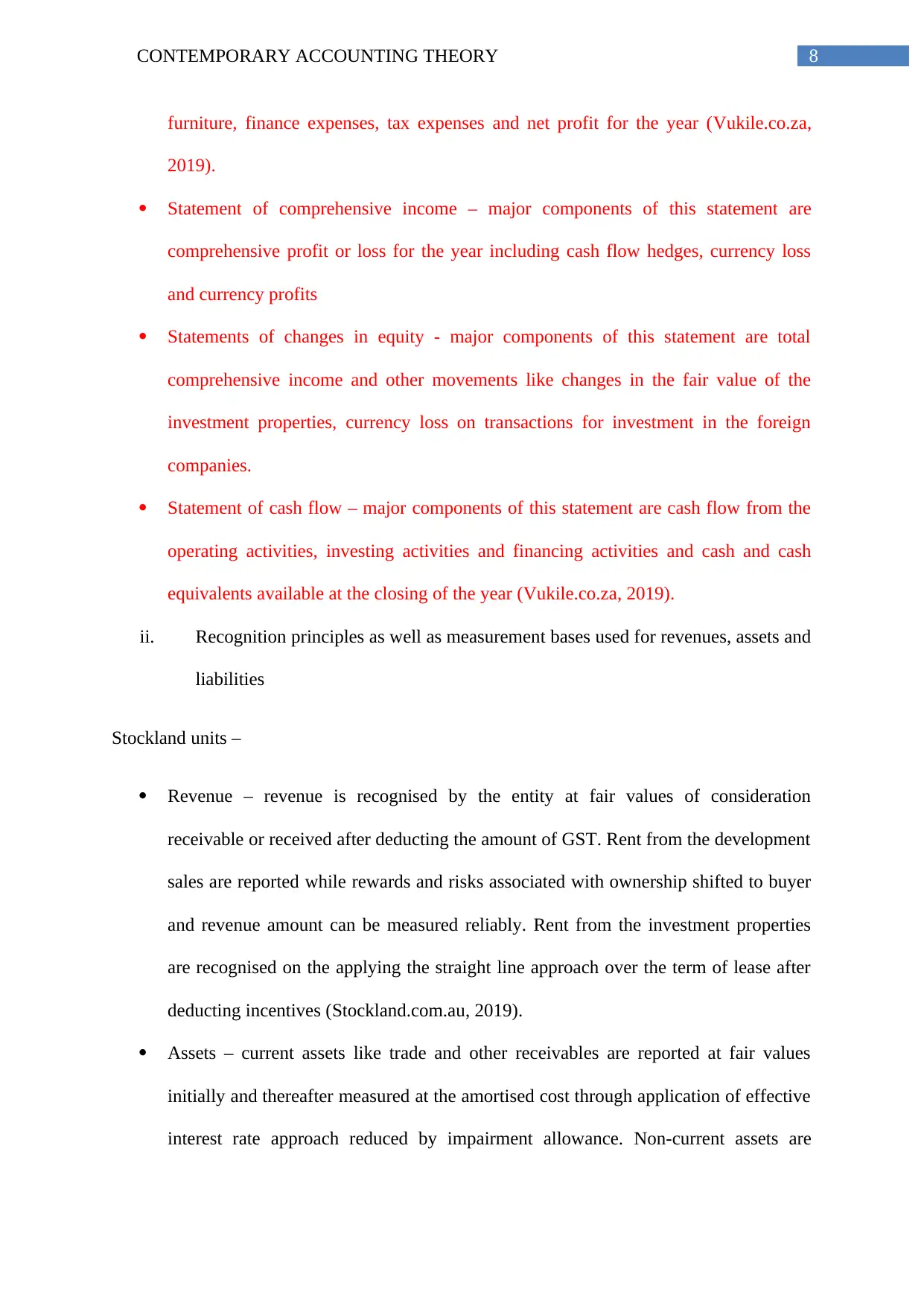
8CONTEMPORARY ACCOUNTING THEORY
furniture, finance expenses, tax expenses and net profit for the year (Vukile.co.za,
2019).
Statement of comprehensive income – major components of this statement are
comprehensive profit or loss for the year including cash flow hedges, currency loss
and currency profits
Statements of changes in equity - major components of this statement are total
comprehensive income and other movements like changes in the fair value of the
investment properties, currency loss on transactions for investment in the foreign
companies.
Statement of cash flow – major components of this statement are cash flow from the
operating activities, investing activities and financing activities and cash and cash
equivalents available at the closing of the year (Vukile.co.za, 2019).
ii. Recognition principles as well as measurement bases used for revenues, assets and
liabilities
Stockland units –
Revenue – revenue is recognised by the entity at fair values of consideration
receivable or received after deducting the amount of GST. Rent from the development
sales are reported while rewards and risks associated with ownership shifted to buyer
and revenue amount can be measured reliably. Rent from the investment properties
are recognised on the applying the straight line approach over the term of lease after
deducting incentives (Stockland.com.au, 2019).
Assets – current assets like trade and other receivables are reported at fair values
initially and thereafter measured at the amortised cost through application of effective
interest rate approach reduced by impairment allowance. Non-current assets are
furniture, finance expenses, tax expenses and net profit for the year (Vukile.co.za,
2019).
Statement of comprehensive income – major components of this statement are
comprehensive profit or loss for the year including cash flow hedges, currency loss
and currency profits
Statements of changes in equity - major components of this statement are total
comprehensive income and other movements like changes in the fair value of the
investment properties, currency loss on transactions for investment in the foreign
companies.
Statement of cash flow – major components of this statement are cash flow from the
operating activities, investing activities and financing activities and cash and cash
equivalents available at the closing of the year (Vukile.co.za, 2019).
ii. Recognition principles as well as measurement bases used for revenues, assets and
liabilities
Stockland units –
Revenue – revenue is recognised by the entity at fair values of consideration
receivable or received after deducting the amount of GST. Rent from the development
sales are reported while rewards and risks associated with ownership shifted to buyer
and revenue amount can be measured reliably. Rent from the investment properties
are recognised on the applying the straight line approach over the term of lease after
deducting incentives (Stockland.com.au, 2019).
Assets – current assets like trade and other receivables are reported at fair values
initially and thereafter measured at the amortised cost through application of effective
interest rate approach reduced by impairment allowance. Non-current assets are
⊘ This is a preview!⊘
Do you want full access?
Subscribe today to unlock all pages.

Trusted by 1+ million students worldwide
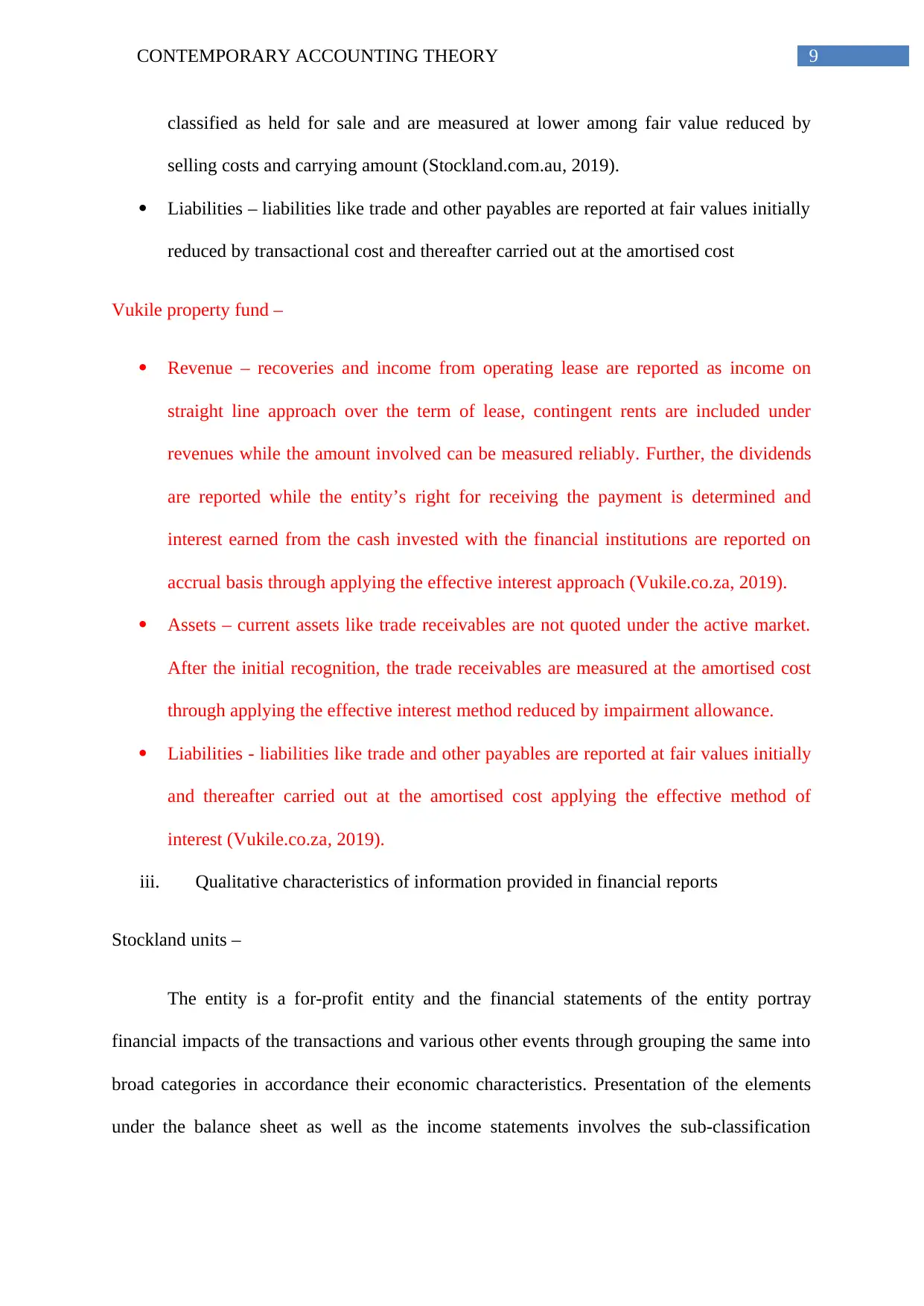
9CONTEMPORARY ACCOUNTING THEORY
classified as held for sale and are measured at lower among fair value reduced by
selling costs and carrying amount (Stockland.com.au, 2019).
Liabilities – liabilities like trade and other payables are reported at fair values initially
reduced by transactional cost and thereafter carried out at the amortised cost
Vukile property fund –
Revenue – recoveries and income from operating lease are reported as income on
straight line approach over the term of lease, contingent rents are included under
revenues while the amount involved can be measured reliably. Further, the dividends
are reported while the entity’s right for receiving the payment is determined and
interest earned from the cash invested with the financial institutions are reported on
accrual basis through applying the effective interest approach (Vukile.co.za, 2019).
Assets – current assets like trade receivables are not quoted under the active market.
After the initial recognition, the trade receivables are measured at the amortised cost
through applying the effective interest method reduced by impairment allowance.
Liabilities - liabilities like trade and other payables are reported at fair values initially
and thereafter carried out at the amortised cost applying the effective method of
interest (Vukile.co.za, 2019).
iii. Qualitative characteristics of information provided in financial reports
Stockland units –
The entity is a for-profit entity and the financial statements of the entity portray
financial impacts of the transactions and various other events through grouping the same into
broad categories in accordance their economic characteristics. Presentation of the elements
under the balance sheet as well as the income statements involves the sub-classification
classified as held for sale and are measured at lower among fair value reduced by
selling costs and carrying amount (Stockland.com.au, 2019).
Liabilities – liabilities like trade and other payables are reported at fair values initially
reduced by transactional cost and thereafter carried out at the amortised cost
Vukile property fund –
Revenue – recoveries and income from operating lease are reported as income on
straight line approach over the term of lease, contingent rents are included under
revenues while the amount involved can be measured reliably. Further, the dividends
are reported while the entity’s right for receiving the payment is determined and
interest earned from the cash invested with the financial institutions are reported on
accrual basis through applying the effective interest approach (Vukile.co.za, 2019).
Assets – current assets like trade receivables are not quoted under the active market.
After the initial recognition, the trade receivables are measured at the amortised cost
through applying the effective interest method reduced by impairment allowance.
Liabilities - liabilities like trade and other payables are reported at fair values initially
and thereafter carried out at the amortised cost applying the effective method of
interest (Vukile.co.za, 2019).
iii. Qualitative characteristics of information provided in financial reports
Stockland units –
The entity is a for-profit entity and the financial statements of the entity portray
financial impacts of the transactions and various other events through grouping the same into
broad categories in accordance their economic characteristics. Presentation of the elements
under the balance sheet as well as the income statements involves the sub-classification
Paraphrase This Document
Need a fresh take? Get an instant paraphrase of this document with our AI Paraphraser
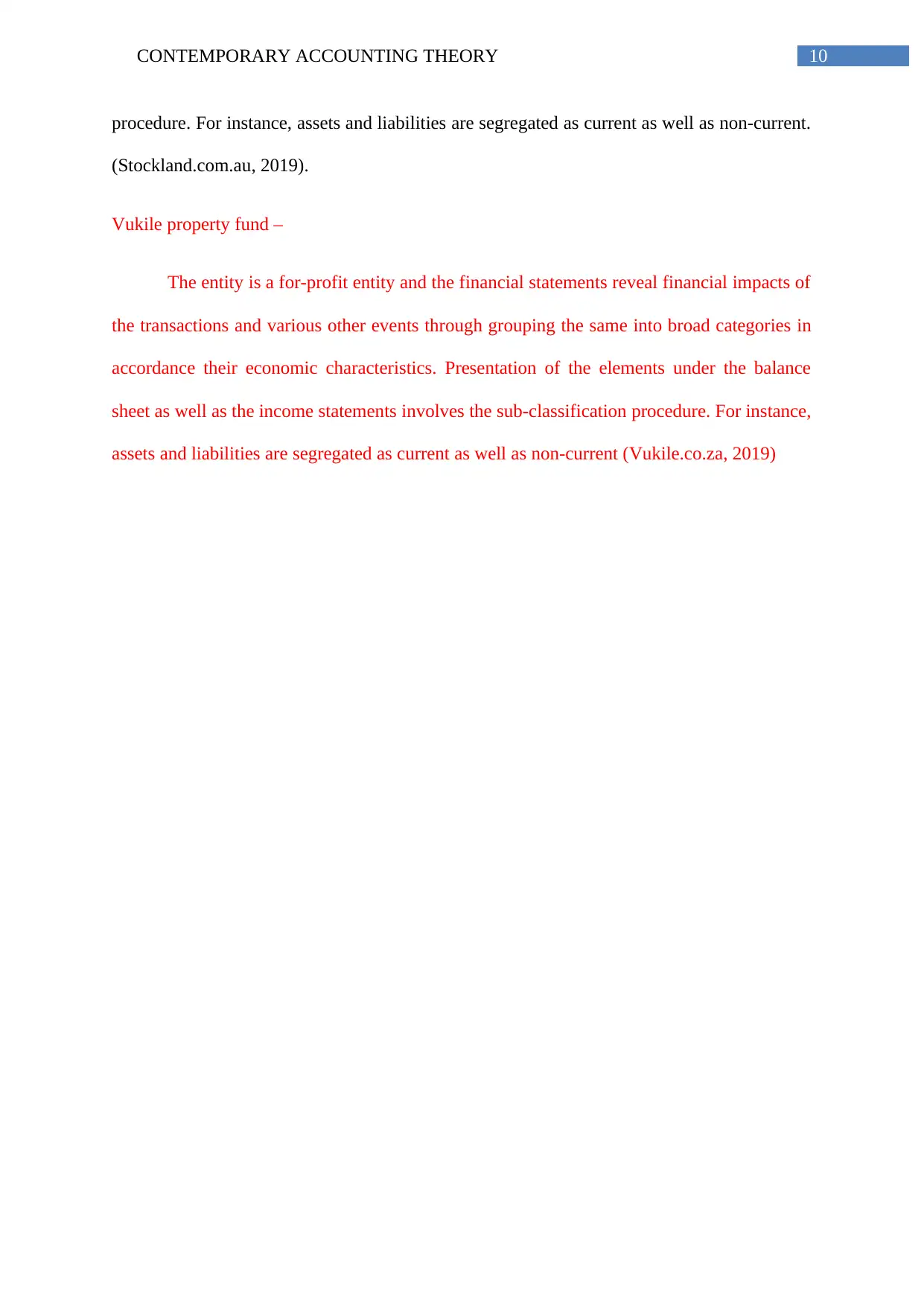
10CONTEMPORARY ACCOUNTING THEORY
procedure. For instance, assets and liabilities are segregated as current as well as non-current.
(Stockland.com.au, 2019).
Vukile property fund –
The entity is a for-profit entity and the financial statements reveal financial impacts of
the transactions and various other events through grouping the same into broad categories in
accordance their economic characteristics. Presentation of the elements under the balance
sheet as well as the income statements involves the sub-classification procedure. For instance,
assets and liabilities are segregated as current as well as non-current (Vukile.co.za, 2019)
procedure. For instance, assets and liabilities are segregated as current as well as non-current.
(Stockland.com.au, 2019).
Vukile property fund –
The entity is a for-profit entity and the financial statements reveal financial impacts of
the transactions and various other events through grouping the same into broad categories in
accordance their economic characteristics. Presentation of the elements under the balance
sheet as well as the income statements involves the sub-classification procedure. For instance,
assets and liabilities are segregated as current as well as non-current (Vukile.co.za, 2019)
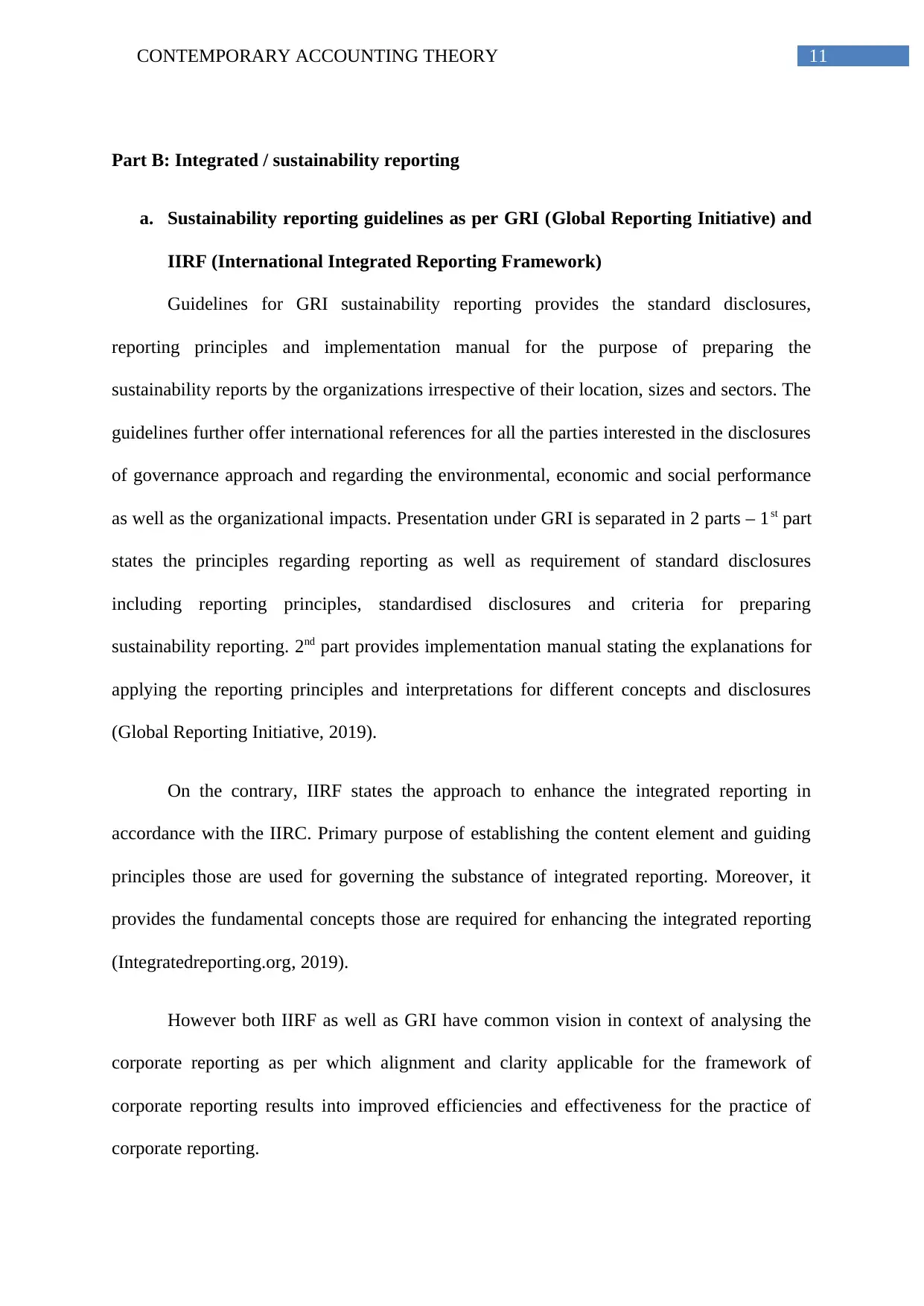
11CONTEMPORARY ACCOUNTING THEORY
Part B: Integrated / sustainability reporting
a. Sustainability reporting guidelines as per GRI (Global Reporting Initiative) and
IIRF (International Integrated Reporting Framework)
Guidelines for GRI sustainability reporting provides the standard disclosures,
reporting principles and implementation manual for the purpose of preparing the
sustainability reports by the organizations irrespective of their location, sizes and sectors. The
guidelines further offer international references for all the parties interested in the disclosures
of governance approach and regarding the environmental, economic and social performance
as well as the organizational impacts. Presentation under GRI is separated in 2 parts – 1st part
states the principles regarding reporting as well as requirement of standard disclosures
including reporting principles, standardised disclosures and criteria for preparing
sustainability reporting. 2nd part provides implementation manual stating the explanations for
applying the reporting principles and interpretations for different concepts and disclosures
(Global Reporting Initiative, 2019).
On the contrary, IIRF states the approach to enhance the integrated reporting in
accordance with the IIRC. Primary purpose of establishing the content element and guiding
principles those are used for governing the substance of integrated reporting. Moreover, it
provides the fundamental concepts those are required for enhancing the integrated reporting
(Integratedreporting.org, 2019).
However both IIRF as well as GRI have common vision in context of analysing the
corporate reporting as per which alignment and clarity applicable for the framework of
corporate reporting results into improved efficiencies and effectiveness for the practice of
corporate reporting.
Part B: Integrated / sustainability reporting
a. Sustainability reporting guidelines as per GRI (Global Reporting Initiative) and
IIRF (International Integrated Reporting Framework)
Guidelines for GRI sustainability reporting provides the standard disclosures,
reporting principles and implementation manual for the purpose of preparing the
sustainability reports by the organizations irrespective of their location, sizes and sectors. The
guidelines further offer international references for all the parties interested in the disclosures
of governance approach and regarding the environmental, economic and social performance
as well as the organizational impacts. Presentation under GRI is separated in 2 parts – 1st part
states the principles regarding reporting as well as requirement of standard disclosures
including reporting principles, standardised disclosures and criteria for preparing
sustainability reporting. 2nd part provides implementation manual stating the explanations for
applying the reporting principles and interpretations for different concepts and disclosures
(Global Reporting Initiative, 2019).
On the contrary, IIRF states the approach to enhance the integrated reporting in
accordance with the IIRC. Primary purpose of establishing the content element and guiding
principles those are used for governing the substance of integrated reporting. Moreover, it
provides the fundamental concepts those are required for enhancing the integrated reporting
(Integratedreporting.org, 2019).
However both IIRF as well as GRI have common vision in context of analysing the
corporate reporting as per which alignment and clarity applicable for the framework of
corporate reporting results into improved efficiencies and effectiveness for the practice of
corporate reporting.
⊘ This is a preview!⊘
Do you want full access?
Subscribe today to unlock all pages.

Trusted by 1+ million students worldwide
1 out of 19
Related Documents
Your All-in-One AI-Powered Toolkit for Academic Success.
+13062052269
info@desklib.com
Available 24*7 on WhatsApp / Email
![[object Object]](/_next/static/media/star-bottom.7253800d.svg)
Unlock your academic potential
Copyright © 2020–2025 A2Z Services. All Rights Reserved. Developed and managed by ZUCOL.





